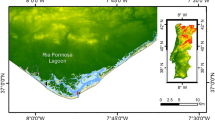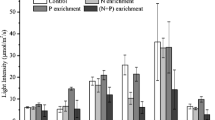Summary
Water samples from coastal lakes and ponds on Ross Island (77°S) and from the adjacent Ross Sea were analyzed to determine nutrient supply relative to the population size of planktonic algae and bacteria. An enrichment test was applied to each water to measure N and P accumulation by the seston as a guide to nutrient demand and deficiency. In all waters, including the sea, the dissolved inorganic N-to-P ratios were low, but inorganic nitrogen was generally present at concentrations that satisfied or exceeded the current growth requirements of the algae. None of the samples responded to added P, and only 3 of the 13 plankton assemblages tested responded positively to nitrogen enrichment. These waters are therefore characterized by an abundance of resources relative to demand. This apparently r-selecting coastal environment contrasts markedly in many ecosystem properties with the inland meromictic lakes of Antarctica.
Similar content being viewed by others
References
Broady PA (1981) Non-marine algae of Cape Bird, Ross Island and Taylor Valley, Victoria Land, Antarctica. Melbourne University Programme in Antarctic Studies Report No 37, p 97
Burton HR (1981) Chemistry, physics and evolution of Antarctic saline lakes. Hydrobiologia 82:339–362
Downes MT (1978) An automated determination of low reactive phosphorus in natural waters in the presence of arsenic, silicon and mercuric chloride. Wat Res 12:743–745
El-Sayed SZ (1970) On the productivity of the Southern Ocean. In: Holdgate MW (ed) Antarctic ecology, vol 1. Academic Press, London, New York, pp 119–135
Goldman CR, Mason DT, Wood BJB (1972) Comparative study of the limnology of two small lakes on Ross Island, Antarctica. In: Llano GA (ed) Antarctic Terrestrial Biology. American Geophysical Union, Washington DC, pp 1–50
Harold FM (1966) Inorganic polyphosphates in biology: structure, metabolism and function. Bact Rev 30:772–794
Healey FP (1979) Short-term responses of nutrient-deficient algae to nutrient addition. J Phycol 15:289–299
Holm-Hansen O, El-Sayed SZ, Franceschini GA, Cuhel RL (1977) Primary production and the factors controlling phytoplankton growth in the Southern Occan. In: Llano GA (ed) Adaptations within Antarctic Ecosystems. Smithsonian Institution, Washington DC, pp 11–50
Jones JG, Simon BM (1975) An investigation of errors in direct counts of aquatic bacteria by epifluorescence microscopy with reference to a new method of dyeing membrane filters. J Appl Bacteriol 39:317–329
Kilham P, Kilham SS (1980) The evolutionary ecology of phytoplankton In: Morris I (ed) The physiological ecology of phytoplankton Blackwell Scientific Publications, Oxford, pp 571–597
Lewis EL, Perkin RG (1981) The practical salinity scale 1978: conversion of existing data. Deep Sea Res 28A:307–328
McCarthy JJ, Taylor WR, Taft JL (1977) Nitrogenous nutrition of the plankton in Chesapeake Bay. Limnol Oceanogr 22:996–1011
McCarthy JJ, Goldman JC (1979) Nitrogenous nutrition of marine phytoplankton in nutrient-depleted waters. Science 203:670–672
Murray J (1910) Antarctic Rotifera. In: Murray J (ed) British Antarctic Expedition 1907–1909, Reports on the Scientific Investigations: Biology, vol 1 (pt III). Heineman, London, pp 41–73
Olson RJ (1980) Nitrate and ammonium uptake in Antarctic waters. Limnol Oceanogr 25:1064–1074
Perry MJ (1976) Phosphate utilization by an oceanic diatom in phosphorus-limited chemostat culture and in the oligotrophic waters of the central North Pacific. Limnol Oceanogr 21:88–107
Redfield AC, Ketchum BH, Richards FA (1963) The influence of organisms on the composition of seawater. In: Hill MN (ed) The sea, vol 2. Wiley-Interscience, New York, pp 26–76
Samsel GA, Parker BC (1972) Limnological investigations in the area of Anvers Island, Antarctica. Hydrobiologia 40:505–511
Searle PL (1975) Automated colorimetric determination of ammonium ions in soil extracts with ‘Technicon AutoAnalyzer II’ equipment. NZ J Agric Res 18:183–187
Spurr B (1975) Limnology of Bird Pond, Ross Island, Antarctica. NZ J Mar Freshwat Res 9:547–562
Talling JF, Driver D (1963) Some problems in the estimation of chlorophyll α in phytoplankton. In: Doty MS (ed) Proceedings of a Conference on Primary Productivity Measurement, Marine and Fresh-water. US Atomic Energy Commission, pp 142–146
Torii T (1975) Geochemical and geophysical studies of the dry valleys, South Victoria Land in Antarctica. National Inst of Polar Res, Tokyo, p 89
Vincent WF (1981a) Rapid physiological assays for nutrient demand by the plankton. I. Nitrogen. J Plankton Res 3:685–697
Vincent WF (1981b) Rapid physiological assays for nutrient demand by the plankton. II. Phosphorus. J Plankton Res 3:699–710
Vincent WF (1981c) Production strategies in Antarctic inland waters: phytoplankton eco-physiology in a permanently ice-covered lake. Ecology 62:1215–1224
Vincent WF, Downes MT, Vincent CL (1981) Nitrous oxide cycling in Lake Vanda, Antarctica. Nature 292:618–620
Vincent WF, Vincent CL (1982) Controlling factors for algal production in Lake Vanda (77°S). Can J Fish Aquat Sci (in press)
Wetzel RG (1975) Limnology. Saunders, New York
Woods JL (1976) Aspects of the biology of the Antarctic freshwater rotifer Philodina gregaria. MSc Thesis, University of Canterbury New Zealand
Author information
Authors and Affiliations
Rights and permissions
About this article
Cite this article
Vincent, W.F., Vincent, C.L. Response to nutrient enrichment by the plankton of Antarctic coastal lakes and the inshore Ross Sea. Polar Biol 1, 159–165 (1982). https://doi.org/10.1007/BF00287002
Received:
Accepted:
Issue Date:
DOI: https://doi.org/10.1007/BF00287002




